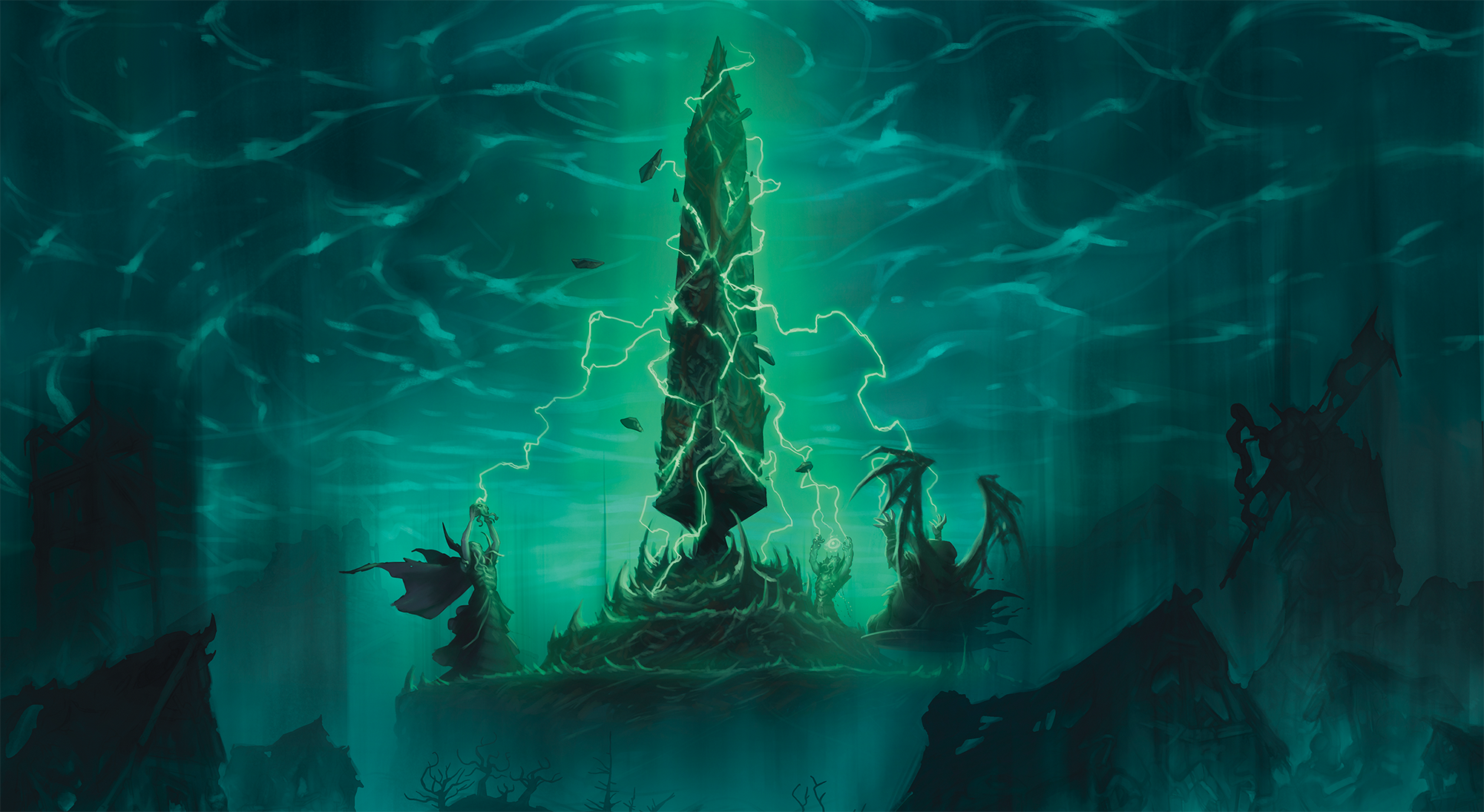In the summer of 2010, I wrote the article now titled Xandering the Dungeon.
That wasn’t the original title of the article, nor the original term I coined to describe both the process of creating a non-linear dungeon (xandering) and the properties of a non-linear dungeon (xandered). The original term was “jaquaying,” which was, of course, an eponymous term I had chosen based on how much the work of Jennell Jaquays had inspired me.
In 2023, for better or for worse, this term was changed to xandering. I want to offer a brief explanation for why this happened.
First, Jennell Jaquays wanted a change. She didn’t like that the term dropped the “s” from her name. Her name is very important to her. This wasn’t a problem. In fact, Jennell had previously requested some sweeping changes to the article for similar reasons, and I’d made those changes. Based on that experience, though, I knew that making this change would not be a quick or easy process: It took weeks of effort, followed by months of extra work to make sure all the metadata had been properly scrubbed on the site. Making this change would be even more substantive, because I’d been using the term for over a decade and I’d need to track it down in every single article. (As I’m writing this, in fact, I’m still in the middle of that work.)
Second, Jennell’s preference for a change in the term had been mentioned in some interviews. Unfortunately, this began a harassment campaign: Whenever somebody used the term “jaquaying the dungeon” they would be targeted. Some of this just took the form of saying, “You shouldn’t use that word.” Some of it escalated to claiming the word was bigoted. In a few cases, I’ve had people tell me they received death threats.
And to be as crystal clear as possible here: Jennell had absolutely nothing to do with the harassment. She didn’t want it. She didn’t encourage it. And if anyone tries to use this as an occasion to be an asshole and harass her or her fans, I’d really like to emphasize that (a) you are no fan of mine and (b) you can come for me first, because I’m definitely a fan of hers.
Obviously, however, this could not be allowed to continue.
I spoke with Jennell earlier this year. We both agreed that the name should be changed, and I said it would be a large project to do it, but I’d make sure it happened by the end of the year.
The final factor here is that I had also been working on So You Want to Be a Game Master, a book in which I discussed non-linear dungeon design that had originally used the term “jaquaying.” So I contacted the publisher and said, “We need to make sure we change this term.”
Long story short, this created a legal question. Not an arduous or terrible one. But one that resulted in the conclusion, “There is some risk in using a word based on someone else’s name. Let’s not do that.”
One option at this point would have been to drop the neologism entirely and just refer to “non-linear dungeons.” But I’d originally created a verb because I found a verb useful; other people had found the verb useful over the years; and it would be substantially easier to update all of the various articles that had used the term over the years if I could just swap one word out for another. (As opposed to rewriting entire articles.)
After a bunch of back-and-forth, we (UPDATE: me and the publisher; the “we” mentioned in previous paragraphs who “need to make this change”) finally settled on the term “xandering.” And so, from this point forward, my dungeons will be thoroughly xandered.
UPDATE: There has been interest in a more precise or detailed sequence of events. To hopefully make things as clear as possible without obfuscating what this article originally said, the sequence of events in early 2023 is: Jennell and I spoke about changing the article. Legal questions resulted in a new term being selected. I let Jennell know that the site would be updated by the end of the year. She thanked me. That conversation, in April 2023, was our last before she became ill. The book was then updated for publication. From September thru October of 2023, I worked on updating every article using the original term on the site. I then posted this historical note on November 1st, and spent another couple weeks updating posts and metadata that had been missed in the original update.
If you’re reading this historical note in November 2023, shortly after I’ve posted it, then there’s likely still a few instances of the old term floating around the website. If you’re reading this in the mid-term future, then this is likely the only place on the Alexandrian where you’ll still find the term being used. If you’re reading this even further out, then it’s possible you’ve never even heard of “jaquaying the dungeon.”
There’s a part of me that feels sad about that. But I also know that this was the right thing to do and that it needed to happen.
FAQs
You can’t do this!
I can.
This is, honestly, one of the reasons why the term needed to be changed. People were somehow convinced that I was not the creator of Xandering the Dungeon.
To be really clear here: I wrote the article. I invented the word (both the old one and the new one). I created the categories of techniques and level connectors. It’s my work.
So, yes, I can do this. And, for the reasons described above, I also believe it’s the ethically right thing to do.
I’ve used the old term in my article or video or blog post. What should I do?
Well, I’m not your boss, but if you’d like to respect the wishes of the original creator of the term and the article, it would be great if you could update your stuff to use the now-correct terminology.
If it’s in a form that can’t be easily updated (e.g., a video or printed book), though, please don’t feel like you need to take that material down. You might, however, consider adding a clarifying note in the info-box for your video or making a note to update the text when the book is reprinted.
I see someone using the old term. What should I do?
It’s fine to just do nothing. Particularly if there’s a link to the original article, it’ll sort itself out. (If there’s not a link, though, I won’t dissuade you from pointing people in the right direction.)
I’d rather not see every discussion of the dungeon design principles in Xandering the Dungeon instead turn into a discussion of the term. That’s one of the reasons why the change was necessary, and it would be great if the solution didn’t perpetuate the problem.
Why have you edited comments on your site that used the old term?
To make sure that the update of the site is complete and the term Jennell Jaquays wants removed is totally purged, we wanted to use database updates. It turned out the use of the term in comments was actually a problem and they might get invisibly changed by the search-and-replace. I wasn’t comfortable with that. I also didn’t want to just delete comments. So I opted to track the references manually and update them in a way that indicated the original wording had been edited.
Will links to the old article still work?
Yes.
If they don’t, please let me know what link isn’t working and we’ll get it fixed.
UPDATE: Are you saying that Jennell Jaquays threatened to sue you?
No. The decision that the name of the article needed to not use Jaquays in any form was prompted by legal advice that resulted as a consequence of Jennell asking for the article to be updated. The full and specific chain of events is described above. As previously noted, Jennell was not the one to create or specifically request the term “xandering.”
UPDATE: By removing the term “jaquaying,” are you plagiarizing Jennell Jaquays’ work?
No. Xandering the Dungeon prominently celebrates and champions Jennell’s genius. It always has and, if I have anything to say about it, it always will. Her dungeon designs are both foundational works and also remain examples of excellence that anyone can (and should) learn from. But the article is not a Cliff’s Note summary of some previous article written by Jennell Jaquays, nor was she a co-author as some have suggested. It’s also not accurate to claim that the article only cites her work or that her work is the sole inspiration for the categories of techniques & connections I created. Other works cited include the sample dungeon from the 1974 edition of D&D (Dave Arneson & Gary Gygax), Stone Mountain from the D&D Basic Set (Tom Moldvay & Tom Wham), The Temple of Elemental Evil (Gygax & Frank Mentzer), Dungeonland (Gygax), Star Trek, The Glass Elevator, Greek myth, and The Empire Strikes Back, as well as my own work in Halls of the Mad Mage, Darkwoods’ Secret, and The Lost Hunt.
If I was writing the article today I would also mention, in addition to Jennell’s post-2010 design work, Dave Arneson’s First Fantasy Campaign, Greg Svenson’s Lost Dungeons of Tonigsborg, Rob Kuntz’ El Raja Key, and Pete & Judy Kerestan’s Palace of the Vampire Queen. If you’re interested in diving deeper into early dungeon design, I recommend all of these adventures.
UPDATE: Is it true that you removed all reference to Jennell Jaquays from your article & book?
No. This never happened. You can easily read the article for yourself. She is also given an acknowledgment in the book. Some have claimed that Dave Arneson being mentioned three times, Gary Gygax being mentioned twice, and Jennell Jaquays only being mentioned once in the book is intended as some sort of insult to Jennell’s legacy. If this is so, however, it was not my intention.
UPDATE: Will you be changing the name again?
No. As I’ve attempted to explain in as polite a way as possible, the primary reason for changing the name was because Jaquays’ name in the title was creating the false belief that either I did not write the article and/or that she or others had some legal and/or moral authority over my work.
It’s not so much that nothing has changed, but rather that recent events have proven that these concerns were completely justified and that the situation was, in fact, much worse than I had ever imagined. I am sorry for those who have been hurt by this, but unfortunately that makes the change no less necessary.
This article was updated in January 2024, as indicated above, to reflect discussions with the RPG trans community and to provide additional details as requested.
A longer reflection on these discussions, which may also answer other questions you may have, can be found in the Second Historical Note on Xandering.
PLEASE HELP MS. JAQUAYS
As I was working on this, Jennell Jaquays was hospitalized and diagnosed with Guillain-Barré syndrome. Her wife has posted a GoFundMe, and if you have the means, it would be really, really great if you could help her out.
DONATE HERE













